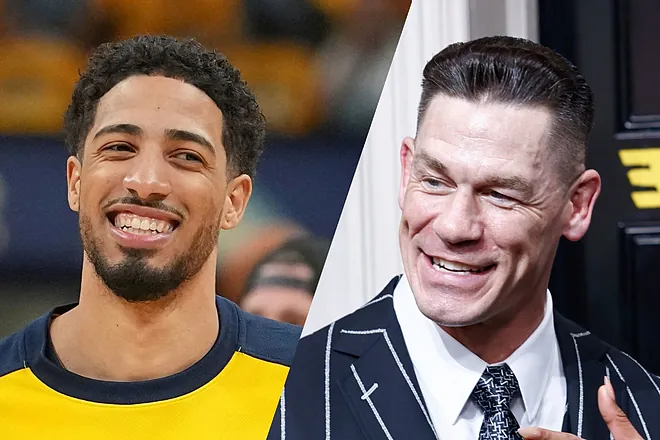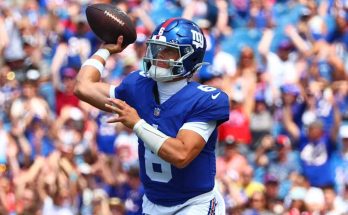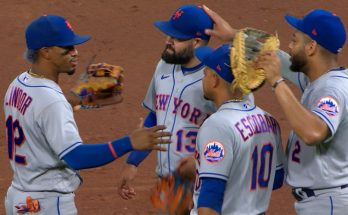Tyrese Haliburton’s appearance at WWE SummerSlam 2025 was never meant to be just a typical celebrity cameo. When he walked into MetLife Stadium on crutches, still recovering from an Achilles tear he suffered during the NBA Finals, most people assumed he was there to enjoy the spectacle like any other star athlete. But what unfolded was far more electric, spontaneous, and culturally resonant than anyone expected. In one of the most surprising and talked-about moments of the weekend, Haliburton found himself becoming part of the action during the main event, helping John Cena deliver a dramatic twist in a match that already carried the emotional weight of a possible farewell.
SummerSlam 2025 was billed as a historic event, split over two nights and staged in the New York–New Jersey area—a location that hadn’t forgotten Haliburton’s role in knocking out the Knicks during the Eastern Conference Finals earlier that year. Knicks fans made their feelings known the moment Haliburton was shown on the big screen. Boos rained down across the stadium, echoing the anger and frustration still lingering from the playoffs. But Haliburton didn’t shrink from the jeers. In fact, he welcomed them with a big grin and a mocking wave. Despite the crutches and the walking boot, he played the heel role like a natural, feeding off the crowd’s energy and encouraging them to boo louder. It was clear he wasn’t just a guest; he was part of the show.
The main event that night was a no-rules street fight between WWE icon John Cena and Cody Rhodes, who had become the face of the company in recent years. This wasn’t just any match—it was one of Cena’s final appearances before retirement. Fans knew they were witnessing the end of an era, and the energy in the building was off the charts. The match itself was brutal, as expected. Tables, chairs, kendo sticks—all fair game. But what nobody saw coming was how Haliburton, a professional basketball player known more for his court vision than any connection to professional wrestling, would become a pivotal part of the bout.
Late in the match, as Cena struggled to gain the upper hand against a relentless Rhodes, he scanned the ringside area for a weapon. His eyes locked on Haliburton, sitting just off to the side with his crutches leaning against the barricade. Cena walked over, made eye contact with Haliburton, and grabbed one of the crutches without saying a word. The gesture was smooth, almost casual, but its impact was instant. The crowd erupted. Cena turned, shouted his signature “You can’t see me!” taunt, then swung the crutch directly into Rhodes’s midsection, dropping him with a thunderous crash. Just like that, the momentum shifted, and the crowd exploded in stunned disbelief.
That moment—Cena using Haliburton’s crutch to attack his opponent—felt organic, chaotic, and cinematic all at once. It wasn’t a scripted handoff or overly choreographed spot. Haliburton didn’t step over the barricade. He didn’t get physical. But the simple act of being the source of Cena’s improvised weaponry made him a key figure in the night’s most important match. As Cena tossed the crutch back toward Haliburton and went back on the offensive, fans were still buzzing, trying to process what they had just seen.
The decision to involve Haliburton in this way wasn’t random. WWE had laid the groundwork months earlier during an episode of SmackDown, when Haliburton had appeared alongside Logan Paul in a segment at Madison Square Garden. In that segment, Haliburton tried to slip brass knuckles to Paul during a match, only to be stopped by none other than Knicks star Jalen Brunson, who intervened and helped Paul’s opponent win. That moment was electric, mixing NBA rivalries with WWE storytelling, and the crowd had eaten it up. By the time SummerSlam rolled around, fans were already familiar with the brewing storyline between Brunson and Haliburton—even if it was rooted in kayfabe and real-life basketball beef.
But at SummerSlam, Brunson wasn’t in the building. Haliburton was alone in enemy territory, and WWE chose to lean into the heat he drew. And it worked. His very presence added another layer to the story unfolding in the ring. When Cena grabbed the crutch, it wasn’t just about using a foreign object—it was about turning real-life sports heat into wrestling drama. It was about taking a villain in the eyes of New York sports fans and making him an accessory to a moment of chaos.
After the event, Haliburton wasted no time getting in on the fun. On social media, he posted, “Smh all you had to do was ask, John Cena,” a tongue-in-cheek way of letting the world know he was in on it. He also fired off another line, telling Knicks fans, “Missed y’all too, NY,” complete with a not-so-subtle wink. His tweets quickly went viral, with fans from both the NBA and WWE worlds chiming in. Some called him the best heel in sports entertainment. Others joked that he had better timing than half the WWE roster. Regardless of where you stood, one thing was clear: Haliburton had stolen the show without even stepping inside the ring.
The moment served as a masterclass in crossover storytelling. WWE didn’t force Haliburton into a match he wasn’t trained for. They didn’t push an awkward promo segment or drag out his role. Instead, they let the moment speak for itself. Haliburton was there, the crowd reacted, Cena capitalized, and the story practically wrote itself. The spontaneity of it all made it feel real—more real than most scripted promos could ever hope to be.
From a business standpoint, it was genius. WWE has always embraced celebrity involvement, from Mr. T to Mike Tyson to Bad Bunny. But Haliburton’s participation felt different. It wasn’t about marketing a movie or promoting an album. It was about channeling real sports emotions and using them to fuel a wrestling narrative. That’s rare. And it hit harder because of how subtle and well-executed it was. Fans believed it because it made sense. Cena, an all-time great fighting tooth and nail in what might be his last title shot, taking advantage of an available weapon—even if it belonged to a basketball player? Completely in character. Haliburton, booed and loving it, offering no resistance? Totally in line with how he’d handled New York ever since the Pacers knocked out the Knicks.
For Cena, the crutch moment added one last chapter to his legacy of innovation. He’s always been known for turning little details into iconic moments—think of how he introduced the spinning title belt, or how he reinvented the U.S. Open Challenge to spotlight new talent. Here, he once again showed why he’s a master of ring psychology. He took a courtside crutch and turned it into a headline.
And for Haliburton, it opened up an entirely new dimension to his public persona. Known primarily as a cerebral point guard with elite passing vision, he showed he had a flair for entertainment too. Even injured, even in enemy territory, he leaned into the role WWE presented him and played it to perfection. He didn’t try to be something he wasn’t. He didn’t oversell it. He let the moment breathe and let the crowd’s reaction fill in the blanks. That’s veteran-level performance art.
Looking back, it’s not an exaggeration to say that the Cena–Haliburton twist might be one of the most memorable celebrity moments in WWE history—not because of how big it was, but because of how perfect it was. It felt earned. It felt timely. And most importantly, it felt fun. It brought together fans from two different worlds and gave them something to talk about beyond the usual scripts and stats.
In the weeks that followed, fans continued to debate whether Haliburton might one day step into the ring for real. While that seems unlikely—especially given his long-term basketball future—the question itself is a testament to how effective the moment was. He left fans wanting more. Whether or not it leads to further appearances, Haliburton will forever be part of WWE lore thanks to a perfectly timed assist that only he could deliver.
And in a match that featured legends, stakes, and emotion, it was the moment with the crutch that might live longest in the memory. Not just because it was unexpected, but because it felt like something only live entertainment can deliver. One second, you’re a basketball player watching from the crowd. The next, you’re helping one of the greatest of all time tip the scales in a title fight. That’s wrestling magic. And Tyrese Haliburton just wrote his name into its history.



